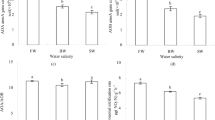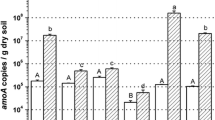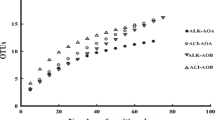Abstract
Nitrification, which is controlled by ammonia-oxidizing archaea (AOA) and bacteria (AOB), is the key step in the nitrogen cycle. Coastal reclaimed farmland is in the conversion stage from coastal mudflat to cultivated farmland and usually suffers from soil salinization. The effects of soil salinity on nitrification and ammonia-oxidizing microorganisms in this soil are rarely reported. Soils with different salinities were collected to conduct an incubation experiment. qPCR and Illumina MiSeq sequencing were used to examine the effects of soil salinity on the abundance, diversity, and community structure of AOA and AOB. Results showed that nitrification was inhibited by increased salinity, while AOA and AOB were both inhibited by soil salinity even if the number of amoA gene copies of AOB was greater than those of AOA. With respect to community diversity, AOA and AOB communities showed a significant shift along the salinity gradient, with AOB diversity indices decreasing significantly with soil salinity, and AOA diversity indices increasing with soil salinity and then decreasing. The community structure of AOB was significantly altered by soil salinity, and the Nitrosomonas cluster increased with soil salinity. However, the effect of soil salinity on the AOA community structure was not significant. Phylogenetic analysis showed that the Nitrosophaera cluster and the Nitrosospira cluster were the predominant clusters in AOA and AOB, respectively. The conclusion could be drawn from the above results that soil salinity inhibited nitrification by suppressing the activities of ammonia-oxidizing microorganisms and influencing their community structures. Meanwhile, ammonia-oxidizing bacteria adapt to soil salinity by means of a strategy in which salt-tolerant species replace salt-intolerant species.






Similar content being viewed by others
References
Aslan S, Simsek E (2012) Influence of salinity on partial nitrification in a submerged biofilter. Bioresour Technol 118:24–29. https://doi.org/10.1016/j.biortech.2012.05.057
Bai JH, Gao HF, Xiao R, Wang JJ, Huang C (2012) A review of soil nitrogen mineralization as affected by water and salt in coastal wetlands: issues and methods. Clean-Soil Air Water 40:1099–1105. https://doi.org/10.1002/clen.201200055
Bassin JP, Kleerebezem R, Muyzer G, Rosado AS, van Loosdrecht MCM, Dezotti M (2012) Effect of different salt adaptation strategies on the microbial diversity, activity, and settling of nitrifying sludge in sequencing batch reactors. Appl Microbiol Biotechnol 93:1281–1294. https://doi.org/10.1007/s00253-011-3428-7
Beman JM, Popp BN, Francis CA (2008) Molecular and biogeochemical evidence for ammonia-oxidizing by marine Crenarchaeota in the Gulf of California. ISME J 2:429–441. https://doi.org/10.1038/ismej.2007.118
Bernhard AE, Landry ZC, Blevins A, de la Torre JR, Giblin AE, Stahl DA (2010) Abundance of ammonia-oxidizing archaea and bacteria along an estuarine salinity gradient in relation to potential nitrification rates. Appl Environ Microbiol 76:1285–1289. https://doi.org/10.1128/AEM.02018-09
Bi QF, Chen QH, Yang XR, Li H, Zheng BX, Zhou WW, Liu XX, Dai PB, Li KJ, Lin XY (2017) Effects of combined application of nitrogen fertilizer and biochar on the nitrification and ammonia oxidizers in an intensive vegetable soil. AMB Express 7:198. https://doi.org/10.1186/s13568-017-0498-7
Canfora L, Bacci G, Pinzari F, Lo Papa G, Dazzi C, Benedetti A (2014) Salinity and bacterial diversity: to what extent does the concentration of salt affect the bacterial community in a saline soil? PLoS ONE 9:e106662. https://doi.org/10.1371/journal.pone.0106662
Chen YL, Xu ZW, Hu HW, Hu YJ, Hao ZP, Jiang Y, Chen BD (2013) Responses of ammonia-oxidizing bacteria and archaea to nitrogen fertilization and precipitation increment in a typical temperate steppe in Inner Mongolia. Appl Soil Ecol 68:36–45. https://doi.org/10.1016/j.apsoil.2013.03.006
Chen QH, Qi LY, Bi QF, Dai PB, Sun DS, Sun CL, Liu WJ, Lu LL, Ni WZ, Lin XY (2015) Comparative effects of 3,4-dimethylpyrazole phosphate (DMPP) and dicyandiamide (DCD) on ammonia-oxidizing bacteria and archaea in a vegetable soil. Appl Microbiol Biotechnol 99:477–487. https://doi.org/10.1007/s00253-014-6026-7
Claros J, Jiménez E, Borrás L, Aguado D, Seco A, Ferrer J, Serralta J (2010) Short-term effect of ammonia concentration and salinity on activity of ammonia oxidizing bacteria. Water Sci Technol 61:3008–3016. https://doi.org/10.2166/wst.2010.217
Cortes-Lorenzo C, Rodriguez-Diaz M, Sipkema D, Juarez-Jimenez B, Rodelas B, Smidt H, Gonzalez-Lopez J (2015) Effect of salinity on nitrification efficiency and structure of ammonia-oxidizing bacterial communities in a submerged fixed bed bioreactor. Chem Eng J 266:233–240. https://doi.org/10.1016/j.cej.2014.12.083
Egamberdieva D, Renella G, Wirth S, Islam R (2010) Secondary salinity effects on soil microbial biomass. Biol Fert Soils 46:445–449. https://doi.org/10.1007/s00374-010-0452-1
Finzi-Hart JA, Pett-Ridge J, Weber PK, Popa R, Fallon SJ, Gunderson T, Hutcheon ID, Nealson KH, Capone DG (2009) Fixation and fate of C and N in the cyanobacterium Trichodesmium using nanometer-scale secondary ion mass spectrometry. Proc Natl Acad Sci 106:6345–6350. https://doi.org/10.1073/pnas.081054
Gao J, Hou LJ, Zheng YL, Liu M, Yin GY, Yu CD, Gao DZ (2018) Shifts in the community dynamics and activity of ammonia-oxidizing prokaryotes along the Yangtze estuarine salinity gradient. J Geophys Res-Biogeo 123:3458–3469. https://doi.org/10.1029/2017jg00418
He LL, Liu Y, Zhao J, Bi YC, Zhao X, Wang SQ, Xing GX (2016) Comparison of straw-biochar-mediated changes in nitrification and ammonia oxidizers in agricultural oxisols and cambosols. Biol Fertility Soils 52:137–149. https://doi.org/10.1007/s00374-015-1059-3
Herrmann M, Saunders AM, Schramm A (2008) Archaea dominate the ammonia-oxidizing community in the rhizosphere of the freshwater macrophyte littorella uniflora. Appl Environ Microbiol 74:3279–3283. https://doi.org/10.1128/AEM.02802-07
Huang QZ, Huang GH (2009) Effects of NaCl salt on mineralization and nitrification of a silt loam soil in the North China Plain. Int J Agric Biol Eng 2:14–23. https://doi.org/10.3965/j.issn.1934-6344.2009.02.014-023
Jang D, Hwang Y, Shin H, Lee W (2013) Effects of salinity on the characteristics of biomass and membrane fouling in membrane bioreactors. Bioresour Technol 141:50–56. https://doi.org/10.1016/j.biortech.2013.02.062
Jiang XJ, Hou XY, Zhou X, Xin XP, Wright A, Ji ZJ (2015) pH regulates key players of nitrification in paddy soils. Soil Biol Biochem 81:9–16. https://doi.org/10.1016/j.soilbio.2014.10.025
Jin WH, Yang JS, Yao RJ, Yu SP, Liu MX, Xie WP (2017) Effects of rice-wheat rotation and afforestation on microbial biomass carbon in coastal salt-affected soils of Eastern China. Pedosphere 27:938–948. https://doi.org/10.1016/S1002-0160(17)60397-7
Kowalchuk GA, Stephen JR, DeBoer W, Prosser JI, Embley TM, Woldendorp JW (1997) Analysis of ammonia-oxidizing bacteria of the beta subdivision of the class Proteobacteria in coastal sand dunes by denaturing gradient gel electrophoresis and sequencing of PCR-amplified 16S ribosomal DNA fragments. Appl Environ Microbiol 63:1489–1497. https://doi.org/10.1128/aem.63.4.1489-1497.1997
Kumar V, Wagenet RJ (1985) Salt effects on urea hydrolysis and nitrification during leaching through laboratory soil columns. Plant Soil 85:219–227. https://doi.org/10.1007/bf02139626
Li M, Gu JD (2013) Community structure and transcript responses of anammox bacteria, AOA, and AOB in mangrove sediment microcosms amended with ammonium and nitrite. Appl Microbiol Biotechnol 97:9859–9874. https://doi.org/10.1007/s00253-012-4683-y
Liu S, Shen L, Lou L, Tian G, Zheng P, Hu B (2013) Spatial distribution and factors shaping the niche segregation of ammonia-oxidizing microorganisms in the Qiantang River, China. Appl Environ Microbiol 79:4065–4071. https://doi.org/10.1128/AEM.00543-13
Lu RK (2000) Soil argrochemistry analysis protocoes. China Agriculture Science Press, Beijing (In Chinese)
Ma Y, Wang L, Qian L (2008) Community structure of β-proteobacterial ammonia-oxidizing bacteria in prawn farm sediment. Prog Nat Sci 18:679–684. https://doi.org/10.1016/j.pnsc.2008.01.013
Magalhaes CM, Joye SB, Moreira RM, Wiebe WJ, Bordalo AA (2005) Effect of salinity and inorganic nitrogen concentrations on nitrification and denitrification rates in intertidal sediments and rocky biofilms of the Douro River estuary, Portugal. Water Res 39:1783–1794. https://doi.org/10.1016/j.watres.2005.03.008
Magalhaes CM, Machado A, Bordalo AA (2009) Temporal variability in the abundance of ammonia-oxidizing bacteria vs. archaea in sandy sediments of the Douro River estuary. Portugal Aquat Microb Ecol 56:13–23. https://doi.org/10.3354/ame01313
Mincer TJ, Church MJ, Taylor LT, Preston C, Kar DM, DeLong EF (2007) Quantitative distribution of presumptive archaeal and bacterial nitrifiers in Monterey Bay and the North Pacific Subtropical Gyre. Environ Microbiol 9:1162–1175. https://doi.org/10.1111/j.1462-2920.2007.01239.x
Mosier AC, Francis CA (2008) Relative abundance and diversity of ammonia-oxidizing archaea and bacteria in the San Francisco Bay estuary. Environ Microbiol 10:3002–3016. https://doi.org/10.1111/j.1462-2920.2008.01764.x
Mukherjee M, Ray A, Post AF, McKay RM, Bullerjahn GS (2016) Identification, enumeration and diversity of nitrifying planktonic archaea and bacteria in trophic end members of the Laurentian Great Lakes. J Great Lakes Res 42:39–49. https://doi.org/10.1016/j.jglr.2015.11.007
Pan CC, Liu CA, Zhao HL, Wang Y (2013) Changes of soil physico-chemical properties and enzyme activities in relation to grassland salinization. Eur J Soil Biol 55:13–19. https://doi.org/10.1016/j.ejsobi.2012.09.009
Park SJ, Park BJ, Rhee SK (2008) Comparative analysis of archaeal 16S rRNA and amoA genes to estimate the abundance and diversity of ammonia-oxidizing archaea in marine sediments. Extremophiles 12:605–615. https://doi.org/10.1007/s00792-008-0165-7
Peng XF Yando E Hildebrand E Dwyer C Kearney A Waciega A Valiela I Bernhard AE (2013) Differential responses of ammonia-oxidizing archaea and bacteria to long-term fertilization in a New England salt marsh. Front Microbiol 3. https://doi.org/10.3389/fmicb.2012.00445
Pitcher A, Villanueva L, Hopmans EC, Schouten S, Reichart GJ, Damste JSS (2011) Niche segregation of ammonia-oxidizing archaea and anammox bacteria in the Arabian Sea oxygen minimum zone. ISME J 5:1896–1904. https://doi.org/10.1038/ismej.2011.60
Qiu G, Ting Y-P (2013) Osmotic membrane bioreactor for wastewater treatment and the effect of salt accumulation on system performance and microbial community dynamics. Bioresour Technol 150:287–297. https://doi.org/10.1016/j.biortech.2013.09.090
Santoro AE, Francis CA, de Sieyes NR, Boehm AB (2008) Shifts in the relative abundance of ammonia-oxidizing bacteria and archaea across physicochemical gradients in a subterranean estuary. Environ Microbiol 10:1068–1079. https://doi.org/10.1111/j.1462-2920.2007.01547.x
Setia R, Marschner P, Baldock J, Chittleborough D, Verma V (2011) Relationships between carbon dioxide emission and soil properties in salt-affected landscapes. Soil Biol Biochem 43:667–674. https://doi.org/10.1016/j.soilbio.2010.12.004
Shen JP, Zhang LM, Zhu YG, Zhang JB, He JZ (2008) Abundance and composition of ammonia-oxidizing bacteria and ammonia-oxidizing archaea communities of an alkaline sandy loam. Environ Microbiol 10:1601–1611. https://doi.org/10.1111/j.1462-2920.2008.01578.x
Shen XY, Zhang LM, Shen JP, Li LH, Yuan CL, He JZ (2011) Nitrogen loading levels affect abundance and composition of soil ammonia oxidizing prokaryotes in semiarid temperate grassland. J Soils Sediments 11:1243. https://doi.org/10.1007/s11368-011-0375-y
Shen JP, Zhang LM, Di HJ, He JZ (2012) A review of ammonia-oxidizing bacteria and archaea in Chinese soils. Front Microbiol 3:296. https://doi.org/10.3389/fmicb.2012.00296
Veettil VP, Abdulaziz A, Chekidhenkuzhiyil J, Ramkollath LK, Hamza FK, Kalam BK, Ravunnikutty MK, Nair S (2015) Bacterial domination over archaea in ammonia oxidation in a monsoon-driven tropical estuary. Microb Ecol 69:544–553. https://doi.org/10.1007/s00248-014-0519-x
Verhamme DT, Prosser JI, Nicol GW (2011) Ammonia concentration determines differential growth of ammonia-oxidising archaea and bacteria in soil microcosms. ISME J 5:1067–1071. https://doi.org/10.1038/ismej.2010.191
Wang ZQ (1993) Salt-affected Soils of China. Science Press, Beijing (In Chinese)
Wang BZ, Zhao J, Guo ZY, Ma J, Xu H, Jia ZJ (2015) Differential contributions of ammonia oxidizers and nitrite oxidizers to nitrification in four paddy soils. ISME J 9:1062–1075. https://doi.org/10.1038/ismej.2014.194
Wankel SD, Mosier AC, Hansel CM, Paytan A, Francis CA (2011) Spatial variability in nitrification rates and ammonia-oxidizing microbial communities in the agriculturally impacted Elkhorn Slough Estuary, California. Appl Environ Microbiol 77:269–280. https://doi.org/10.1128/AEM.01318-10
Xia WW, Zhang CX, Zeng XW, Feng YZ, Weng JH, Lin XG, Zhu JG, Xiong ZQ, Xu J, Cai ZC, Jia ZJ (2011) Autotrophic growth of nitrifying community in an agricultural soil. ISME J 5:1226–1236. https://doi.org/10.1038/ismej.2011.5
Yan N, Marschner P, Cao W, Zuo C, Qin W (2015) Influence of salinity and water content on soil microorganisms. Int Soil Water Conserv Res 3:316–323. https://doi.org/10.1016/j.iswcr.2015.11.003
Yao RJ, Yang JS, Wang XP, Xie WP, Zheng FL, Li HQ, Tang C, Zhu H (2020) Response of soil characteristics and bacterial communities to nitrogen fertilization gradients in a coastal salt-affected agroecosystem. Land Degrad Dev 32:338–353. https://doi.org/10.1002/ldr.3705
Yao R, Li H, Yang J, Zhu W, Yin C, Wang X, Xie W, Zhang X (2022) Combined application of biochar and N fertilizer shifted nitrification rate and amoA gene abundance of ammonia-oxidizing microorganisms in salt-affected anthropogenic-alluvial soil. Appl Soil Ecol 171:104348. https://doi.org/10.1016/j.apsoil.2021.104348
Yu YX, Zhao CY, Jia HT (2016) Ability of split urea applications to reduce nitrous oxide emissions: a laboratory incubation experiment. Appl Soil Ecol 100:75–80. https://doi.org/10.1016/j.apsoil.2015.12.009
Yu YX, Zhao CY, Zheng NG, Jia HT, Yao HY (2019) Interactive effects of soil texture and salinity on nitrous oxide emissions following crop residue amendment. Geoderma 337:1146–1154. https://doi.org/10.1016/j.geoderma.2018.11.012
Zhang Y, Chen LJ, Dai TJ, Tian JP, Wen DH (2015) The influence of salinity on the abundance, transcriptional activity, and diversity of AOA and AOB in an estuarine sediment: a microcosm study. Appl Microbiol Biotechnol 99:9825–9833. https://doi.org/10.1007/s00253-015-6804-x
Zhang Y, Chen LJ, Sun RH, Dai TJ, Tian JP, Zheng W, Wen DH (2016) Population and diversity of ammonia-oxidizing archaea and bacteria in a pollutants’ receiving area in Hangzhou Bay. Appl Microbiol Biotechnol 100:6035–6045. https://doi.org/10.1007/s00253-016-7421-z
Zhang KP, Shi Y, Cui XQ, Yue P, Li KH, Liu XJ, Tripathi BM, Chu HY (2019) Salinity is a key determinant for soil microbial communities in a desert ecosystem. Msystems 4:e00225-e318. https://doi.org/10.1128/mSystems.00225-18
Zhang WW, Wang C, Xue R, Wang LJ (2019) Effects of salinity on the soil microbial community and soil fertility. J Integr Agr 18:1360–1368. https://doi.org/10.1016/s2095-3119(18)62077-5
Zhou X, Fornara D, Wasson EA, Wang DM, Ren GD, Christie P, Jia ZJ (2015) Effects of 44 years of chronic nitrogen fertilization on the soil nitrifying community of permanent grassland. Soil Biol Biochem 91:76–83. https://doi.org/10.1016/j.soilbio.2015.08.031
Funding
This research was funded by the National Natural Science Foundation of China (U1806215, 41977015, U1906221), the National Key Research and Development Project of China (2021YFD1900602, 2021YFC3201201), and the Engineering Research Center of Ecology and Agricultural Use of Wetland, Ministry of Education (KF202115).
Author information
Authors and Affiliations
Corresponding author
Ethics declarations
Conflict of Interest
The authors declare no competing interests.
Additional information
Publisher's Note
Springer Nature remains neutral with regard to jurisdictional claims in published maps and institutional affiliations.
Supplementary Information
Below is the link to the electronic supplementary material.
Rights and permissions
About this article
Cite this article
Zhu, H., Yang, J., Li, Y. et al. Effects of Soil Salinity on Nitrification and Ammonia-Oxidizing Microorganisms in Coastal Reclaimed Farmland Soil. J Soil Sci Plant Nutr 22, 2743–2754 (2022). https://doi.org/10.1007/s42729-022-00841-9
Received:
Accepted:
Published:
Issue Date:
DOI: https://doi.org/10.1007/s42729-022-00841-9




